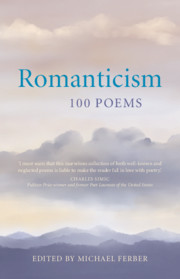Book contents
- Romanticism: 100 Poems
- Romanticism: 100 Poems
- Copyright page
- Contents
- Introduction
- Part
- Part
- Part
- Part
- Part
- Joseph Freiherr von Eichendorff (1788–1857; German)
- George Gordon, Lord Byron (1788–1824; English/Scottish)
- Susan Evance (1788?–? English)
- Alphonse de Lamartine (1790–1869; French)
- Percy Bysshe Shelley (1792–1822; English)
- Part
- Part
- Part
- Part
- Part
Joseph Freiherr von Eichendorff (1788–1857; German)
Published online by Cambridge University Press: 17 February 2021
- Romanticism: 100 Poems
- Romanticism: 100 Poems
- Copyright page
- Contents
- Introduction
- Part
- Part
- Part
- Part
- Part
- Joseph Freiherr von Eichendorff (1788–1857; German)
- George Gordon, Lord Byron (1788–1824; English/Scottish)
- Susan Evance (1788?–? English)
- Alphonse de Lamartine (1790–1869; French)
- Percy Bysshe Shelley (1792–1822; English)
- Part
- Part
- Part
- Part
- Part
Summary
Eichendorff was born of an aristocratic Catholic family in Silesia. He studied at the universities of Halle and Heidelberg, but to prepare for a career in the civil service he moved to Vienna in 1810, where he met Friedrich and Dorothea Schlegel, who encouraged his literary interests. Though he was a conscientious official he found his happiness in his family and in writing: novels, stories, and lyric and narrative poems. His most popular prose work is the novella Aus dem Leben eines Taugenichts (From the Life of a Good-for-Nothing), published in 1826. In Germany his lyric poetry has been greatly loved, not only for its quintessentially “Romantic” themes (nostalgia, flights of the spirit, religious feelings in nature, uncanny encounters or emotions at night, love and its loss, the death of a child) but for its clear and simple diction and its musical effects. Some of Eichendorff’s poems are best known through their musical settings by Robert Schumann, a friend of his, who chose twelve poems for his Liederkreis, op. 39 (1840).
- Type
- Chapter
- Information
- Romanticism: 100 Poems , pp. 70 - 72Publisher: Cambridge University PressPrint publication year: 2021

